|
FAQs about Flatworm Identification
1
Related Articles: Flatworms
(incl. Planaria), Pest
Flatworm Control by Anthony Calfo, Worms, Featherduster
Worms,
Related FAQs: Flatworm ID 2, Flatworm ID 3, Flatworms/Planaria 1, Flatworms 2, Flatworms 3, & FAQs on: Flatworm Behavior, Flatworm Compatibility, Flatworm Control, Predator Control, Chemical Control, Flatworm Selection, Flatworm Systems, Flatworm Feeding, Flatworm Disease, Flatworm Reproduction, & Worms, FAQs: Worm Diversity FAQs, FAQs 2,
FAQs 3, & Worm IDs
1, Worm IDs
2, Worm IDs 3, Worm IDs 4,
Worm IDs 5, Worm IDs 6, Worm
IDs 7, Worm IDs 8, & Worm ID
FAQs by Group/Phylum: Flatworm
Identification ID, Nemertean,
Proboscis, Ribbon Worm ID, Nematode, Roundworm ID,
Nematomorpha,
Horsehair Worm ID, Acanthocephalans,
Thorny-headed Worm ID, Polychaete Identification, Polychaete ID 2, Tubeworm ID, Hirudineans, Leech ID, Echiuran Worm ID, Invertebrate
Identification,
|
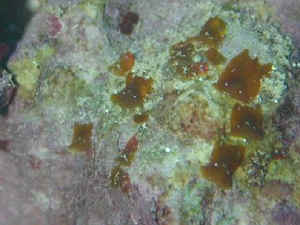
|
So-called "Planaria" [flatworms] Hi I have been
reading from your website and I am trying to figure out if what I have
in my tank is Planaria. I have a 65 gallon tank with live rock, 1
clown, 2 sleeper gobies, 1 coral beauty, 1 powder brown tang, 3
damsels, and a puffer. The tank has been up and thriving for 7 months.
What I have on the bottom of my tank and on the powerhead, thermometer
and rock are white. They appear to have a tail? Not very noticeable and
have not overrun any rock or glass, but I am wondering what they could
be. <we cannot say from the general description and without a clear
photo, but rest assured that there is a common flatworm in aquaria that
is white. Often present when its food is abundant: tiny copepods (white
dots). Do look over: http://www.tcnj.edu/~maughme2/faq.htm and here:
http://www.rshimek.com/ Best regards, Anthony>
Rust-Brown Acoel flatworms 5/20/03 Here is the best pic I
could manage. These guys are maybe 1/8th inch long. I am wondering what
they are and if they are reef dangerous. If they are what will get rid
of them? Anything eat these guys? Shane <the Acoel
flatworms you have, bud, are quite a nuisance and a common problem.
Also know as red/rust/brown "Planaria". One of the genera
represented includes Convolutriloba. Please use the common and
scientific names proffered here to do a keyword Google.com search of
our archives (many FAQs on this topic) and beyond on the Internet. kind
regards, Anthony>
| Flatworm ID - Harmless Here - 8/13/03 Hi
Crew! You guys & gals sure deliver the goods! <thanks kindly
<G> I wonder if someone can tell me what this is and what I
should do with them (hundreds of them!). They are crawling out of
my 4 week old live LS. <your critter is a flatworm/AKA
Planaria... and is actually of the harmless variety. This creature
preys on copepods and is common to flare in young tanks when the
copepod population is strong (yay!) before the tank is overstocked
(booo...) or stocked too quickly (too common). They will wane when
the copepods do. No worries. Best regards Anthony> |
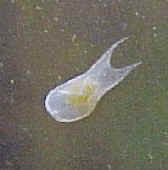
|
| Nudibranch or Flatworm
Hi crew! <Howdy Aryeh>
Last night I was shocked discover in my 200
g reef what looked like a black Nudibranch gliding along the sand
and rocks. It was about 1.5 - 2" long and it sort
of looked like a dog (two ears or antennas in the front and a
little tail sticking up at the back). At first I was
excited (I already have lettuce Nudibranchs) until I looked in the
Reef Invertebrates and saw the picture of the Pseudoceros
sapphrinus. <Looks like that to me too> It looked
very much like that except it didn't have the blue ring around
it. Here's a picture attached (it's the best I
could get). So is it a Nudibranch or a flatworm? <The
latter> If it's the latter, how concerned do I have to be?
<Mmm, not much... I suspect your tank is large (several tens of
gallons in volume) and well-filtered... Should it die, dissolve,
likely no problem. I would just enjoy it for now> I've
already panicked a few times (for instance, when I first saw the
lettuce Nudibranch or a big Bristleworm), only to discover they
were harmless. This thing is kind of neat and I think I
could tolerate minimum damage to the corals. But will it
grow to plague proportions? <Not likely. I think you have a good
mind, attitude toward/re such transients. At least a point of view
I share... Bob Fenner> |
|
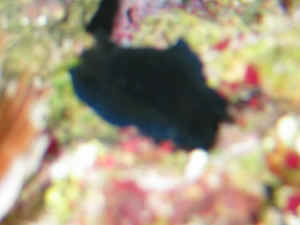
|
| Funny creature... Flatworm eating copepods
9/1/03 Crew. I have had two of these little things making
rounds on my glass.. its fun to watch them.. they almost look like
some sort of jelly fish, appears they maybe are feeding on diatoms?
<actually a flatworm/Planaria feeding on copepods... quite
harmless> I was wondering if you might be able to help me
identify it? They shrink and expand their bodies to move around. I
don't think it would cause any trouble, but any information is
appreciated. Thanks! See image here: http://www.johnslife.com/images/squidly.jpg Thanks
again! John <they wax and wane with the copepod population.
Anthony> |
|
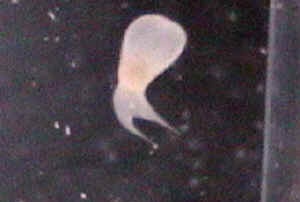
|
| Convolutriloba retrogemma flatworms
10/15/03 Hi Crew! Hope your guys and gals are having as much
fun as these critters - <more fun than you when you hear what
they are at least <G>> they are having a ball in my 2.5
month old 75 gal Reef system. If you could put a name on them I
would appreciate it. <they are the pest Acoel flatworms known as
Convolutriloba retrogemma> I have looked and looked for an ID,
but to no avail. <do also search under the name
"rust/red-brown Planaria". Much in our archives on this
critter and its eradication> Maybe it is the quality of the
photo's...attached is mob scene that may help! Thanks for any
help and keep up the amazing work. Fly 'em High! <they have
symbiotic algae, grow fast in high nutrient systems (do consider if
you have 10-20X water flow and a very efficient skimmer) and do not
eat but rather irritate coral and benthic reef invertebrates. Best
of luck, Anthony> |
|

|
| Convolutriloba retrogemma flatworms
10/16/03 Thanks for the quick ID response Anthony. I just read
the section on pests in your book and it hit the nail on the head!
<very welcome... and no worries, these worms generally wax and
wane in aquaria with little or no harm done. They really do hate
strong water flow, and in concert with aggressive skimming, they
can be easily reduced> As usual this is a self made problem. I
have disconnected the display tank from the refugium, which I am
moving to the basement along with the sump and all support
equipment. I will supply the display via 4 SCWD's feed by a
Dolphin 5600 from the sump. The sump has a circulation pump and
support equipment used to condition water from the
display via a 55 gal refugium. I hope once the turnover is
increased and the supply adequately monitored and massaged, those
pesky little creatures will cease and desist. By the way -
congratulations on the excellent books and I am anxiously waiting
for the next round! <Ahhh... thanks again! I am very eager to
see the next volume in print too :) Kind regards, Anthony> |
Infestation? Dear Bob, I have a 120 gallon reef tank that has
been set up for little over a year. It has 100 pounds of Fiji live
rock, 4 inches of substrate, 3 shrimp, many many hermits of all sorts,
numerous soft and hard corals (both LPS and SPS), two clams, and three
fish (2 clowns and 1 yellow tang). I use two 250 W 6500K metal halides
for the lighting. Other than the usual waxing and waning of some the
animals, and an occasional outbreak of red slime algae on the
substrate, the tank appears to be thriving and the chemical parameters
seem to be where they should be (no nitrates, stable pH, calcium around
380 ppm, alkalinity about 3.25 meq/l). My question is this. About two
months ago I noticed an outbreak of small (around 1 mm) brownish-orange
square-shaped creatures on the substrate and rock. I think they are
some sort of Planaria; at least I know they are animals, because when I
poke them they move. I see no evidence that they are harming any of the
corals or clams in the tank, but they seem to be exploding in numbers.
None of the other animals, shrimp or hermits, appear to be eating these
things. Should I be concerned or is this just one of those phases in
the life of a reef tank? If there is reason to be worried, how would I
control these things? Thanks, Steve Tiffany >> Hmm, I actually
Would Be concerned... maybe not so much for the probability that these
flatworms (yep, methinks they're some sort of "Planaria"
as well) might be/become predatory... but their sheer numbers will
affect, make that mal-affect your water quality... But how to get rid
of them... most are as palatable as the (blue green red algae you
mention... The best starting place is one of the more hardy members of
the dragonet/mandarin/psychedelic goby family (Callionymidae)... maybe
Synchiropus morrisoni if you can find it... If that doesn't work,
keep siphoning... and call me back. Bob Fenner
Reef infestation HI Bob, I have a 55G reef tank that has been
running successfully for 4 1/2 years now. Tank consists of live
rock, and live sand replaced the crushed coral bottom about 2 1/2
years ago. The tank had originally been set up with two 40 W
10,000 K, and two 40 W actinics. In the last six months, I
have upgraded to 4 96W power compact setup. Two problems seemed to
coincide with this new addition. (1) Since the addition of the new
lights, I have seen an ever increasing population of what appears
to be brown slugs or shell less snails all over my live rock and
sand. They don't appear to be damaging anything, just very
unsightly. I have consulted references to try to determine what
these are, but to no avail. They are about 1/16" wide, and
an eighth of an inch long. Light brown in color, with a red tail
end. They propel themselves around on the glass, and hang out in
large groups on the bottom of the tank and are scattered
throughout. When in groups, they actually look like brown algae
covering the sand or rock. I've tried water changes, and just
plain sucking them off the rocks on a daily basis for a week, but
they just come out of the woodwork again , and multiply. They
appear to multiply by division, one splits to create two, two
split to create four, etc. So exponential numbers are attainable
very quickly. I have thought that something might be available to
eat these little buggers, but I don't want to worry about
anything being detrimental to the reef and corals. Someone
had suggested a long nose Hawkfish, but I haven't tried it
yet. I currently have 2 sally light foot crabs, several blue leg
hermits, and a couple brittle stars for scavengers, but that's
it for inverts. Fish include yellow tang, tomato clown, algae
blenny, and gumdrop goby. Please let me know what
your recommendation is. System is also running a Turboflotor 1000
skimmer (awesome piece of equipment), and lights are staged for
about 10 hrs a day. Whew!!!! (Problem 2) Quick one, I promise-
Purple and pink coralline algae were also thriving before the
addition of the custom sea life PC's. Since then, it
has bleached out and only appears to have survived, and is
thriving in the shadows. Too much light? I am debating about
ordering the same bulbs next time, only in 55 W . My local store
has already confirmed these will work with the 96W ballasts. All
corals still appear to be doing very well, and propagation is done
frequently. Let me know your thoughts. Thanks in advance. Brad >>
Thank you for writing and hence being an active part of this forum. The
organisms that you so well describe are no doubt a species of
"free-living" Flatworm (Phylum Platyhelminthes, Class
Turbellaria)... and can be more than an attractive nuisance... There
are a few approaches to their biological control... And I would start
with the two most likely to get you results. A couple of Peppermint
Shrimp (Lysmata wurdemanni) or another species of Lysmata... and a
member of the dragonet/mandarin/psychedelic goby family
(Callionymidae)... my fave is Synchiropus morrisoni... otherwise do
keep vacuuming them out when doing water changes. And the bleaching
incident as you mention is very likely due to the light change... and
Yes to switching to lower wattage lamps. I'd "unplug" one
of your 96W for now... and you do still have the actinics? I'd be
running them an hour before and an hour after the one 96W CF twin... on
timers... Otherwise, keep up your calcium and alkalinity and the
corallines should come back. Bob Fenner
Orange Dots (likely a Platyhelminth) Your book and
WetWebMedia are the best sources for great information! Thank you for
both. <You're welcome my friend.> My reef tank is about
1 year old and doing very well, I think. I have to questions that I was
unable to find answers from the web-site or book. 75-gallon tank. about
60 pound live rock and 60 pound aragonite. (2) 175 watt MH, 5500 &
10000 (10 hrs/day). (2) 40 watt NO (12 hrs/day). turbo skimmer. (1)
magnum 220 with micron filter, use to pump water through UV unit.
18-watt UV unit (12 hrs/day during refugium light cycle). DIY over-flow
box with "Whisper Bio-Bag", replaced weekly. (2) heaters, one
in refugium and the other in the tank. (2) chemical metering pumps used
to feed Kent Tectra CB products separately. Fed daily from 5-gallon
buckets with top-off water (RO/DI). 30-gallon refugium with 10-pounds
live rock and 20-pounds aragonite. (4) 20 watt NO bulbs for refugium,
alternate light cycle from tank. Ca 365 to 400, normal 375 ppm Alk 3.0
to 3.5, normal 3.25 NO3 less then 1 ppm. pH 8.2. Temperature 78F winter
and 82F summer. Specific Gravity 1.0230 to 1.0235, normal 1.0233.
30-gallon water change every 2 to 3 months with RO/DI and Reef
Crystals. Add 1/4 recommended dose of "Seachem" reef iodide
and reef plus (to food) weekly. Foods: Flake, Nori, Krill, Frozen Brine
and my homemade recipe, based on your recipe from the "The
Conscientious Marine Aquarist". <Sounds like a very nice
system> My questions! My mushrooms have orange dots (2mm in size)
that cover them, what are they? <Likely a type of Flatworm (Phylum
Platyhelminthes)... and nothing to be overly worked up about... perhaps
semi-predatory, but not easily removed, not "that"
detrimental... best to leave alone... will likely "disappear"
on their own someday soon> I noticed; today, that they can move
around on the mushroom. The mushrooms completely open and seem fine. Is
this budding reproduction? <No> The only green algae in the tank
is bubble algae probably due to the yellow and purple tangs. How can
prevent the bubble algae from spreading? I have a (matrix?) crab
but he is not interested. Coralline algae covers all of the side and
back glass. <There are a few other predators. These are mentioned on
the "Marine Algae" control FAQs on our site... otherwise, I
would extract what you can by scrubbing the rock involved, ignore the
rest.> My Royal Gramma that is about 1 year old has always appeared
to have a white tint over his front purple part, is this a problem that
can be corrected? <Try a cleaner organism here... otherwise no real
problem> Thank you all the questions you have already answered
through you book and web-site. <That's only for today! Many
lifetimes worth of material still to go. Bob Fenner> Robert
Burns
Polyclad flatworm question Hey guys, <howdy do?> Let me
first thank you all for the hard work you've put into the site.
Having only five weeks into the hobby, the information has proven
invaluable in both the months before and weeks after setting up my
tank. Especially so in helping me selecting appropriate livestock for
my skill level and biotope I am attempting to humbly mimic. <please
keep learning and sharing> So, that being said, I noticed two weeks
ago a Polyclad flatworm played stow-away in a chunk of Fiji liverock.
I've had a dickens of a time trying to find a match in any of the
websites or invertebrate books I've consulted. Unfortunately for
me, I don't own a digital camera to send you a picture. The worm is
fairly large, about 3.5 inches long and elliptical in shape. The front
of the worm is about 1.5inches wide which tapers to about .75-1.0
inches at the back. The worm is a translucent white with brown spots
reminiscent of a leopard skin pattern. <sounds quite
beautiful> The center of the worm (digestive track?) is solid brown.
It seems to be mostly reclusive and diurnal. I'm not so concerned
of making a species identification, but rather if it can pose a toxic
threat. <doesn't sound colorful enough to be likely/very
toxic> None of the livestock in the tank has bothered it, nor have I
seen it go after any fauna in the tank, including sessile invertebrates
of the visible type (since it rarely stops in any one place, I am
wondering if I even have the proper micro fauna established for it to
feed on). <exactly... even as harmless, it is unlikely that you will
have correct/enough food to support it. Good or bad> I'd rather
leave the flatworm in there and enjoy the brief glimpses I can snatch
of it, <agreed> but if it can pose a threat to the health
of the tank (including its inevitable demise), I'll attempt an
extraction. <small risk, IMO leave it in peace and watch closely in
the meantime> Thanks in advance for your assistance, Brian Rice
<best regards, Anthony>
| Odd creature attached to coral ? A flatworm
[picture attached] Anthony, I hope you all had a great
Christmas and I hope the New Year will be good to you all at
WetWebMedia. <and to you in kind, with thanks> With reference
to our previous discussion. Father Christmas delivered
me a digital camera for Christmas. I am still learning
how to use it on manual settings, because auto doesn't work
very well on the tank, it tends to focus on the glass and not the
subject Anyway find attached some shots of the
beast. The last shot was taken by someone else so pass
it around, but please don't publish it. You're
free to do what you will with the rest of the shots. I
will get better with the camera and try to take better
shots. When I get some good shots I will email them to
you. But the following is a taster of things to come.
Thanks, Jon <thank you, my friend... the picture named
"parasite" helped immensely. It is an unmistakable
flatworm. Rather common... indeed parasitic but slow to harm.
Simply remove it with tweezers. It is unlikely to have reproduced
but look for symptoms of offspring just the same in the coming
weeks. Best regards, Anthony> |
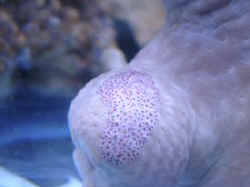
|
Brown Flatworms? - 2/11/03 Hi, <Hello. Paul at your
service> I purchased a small fragment of live rock with a nice
growth of red kelp on it yesterday evening and then placed it in my
tank after some re-arranging. Today, I noticed several (like
20 to 30) small flatworm like animals on the substrate and also on the
kelp itself. <Probably Planaria.> I had never seen this little
creatures before, so I'm not sure if they stowed away on the kelp
and rock or if they were simply hiding under my existing rockwork and
were disturbed when I re-arranged things.<See here: http://www.wetwebmedia.com/flatworms.htm
Do any of these seem like the one exhibited in your rockwork? Probably
there but again could easily have come on the newly acquired piece.
Good argument for quarantine. In any event, I don't think there is
anything to worry about here.> They are less then an 1/8 inch in
length, a brownish green color with a red spot or two on them.<yeah,
definitely starting to sound more and more like a Planaria type
worm> Should I be concerned about these little
hitchhikers? <Not necessarily. They will wax and wane with good flow
and water changes. I have had a few to a few hundred at times in my
years of reefkeeping. Be sure that they don't inhibit
("smother") your photosynthetic
organisms.> Will they eat the algae or possible harm my
current tank inhabitants (a bubble tip anemone, red collared snails,
peppermint shrimp, small red reef hermits). <I am fairly sure they
will have little impact to your tank inhabitants one way or the other
including algae. They come and go.> Is there
anything that would eat the flatworms and leave the other tank
inhabitants alone (preferably invert, not looking to add anymore fish)?
<Check out the preceding link and also this one as well http://www.wetwebmedia.com/pestflatwrmanthony.htm>
Thanks! <You're welcome. Good luck!>
|
Re: what is it I found this critter swimming around in my
invert. tank I've never seen one before. I hope the
attachment helps it is about 1/2 an in. long x 3/16 wide and sort
of flat it swims erratically and is a translucent beige it also
moves by means of the Celia around the back portion. q.-2 a
maroon algae type slime has started to grow in my tank which
I'm sure I imported on a thorny oyster how do I get rid of it
or should I. <Looks, sounds like a flatworm of some sort. If
not many, causing troubles I would ignore it/them. Likely
"they too shall pass". Bob Fenner>
|
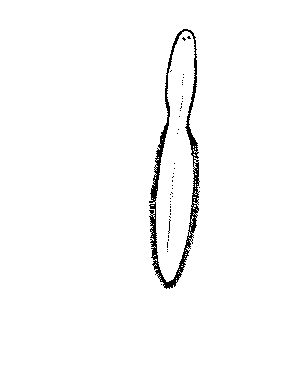
|
Flatworm/Planaria... not the bad kind 6/4/03 Hey there!!
<Howdy-do my aquatic cowgirl! Err... Cheers, I meant to say> I
noticed this critter gliding along the side of one of my tanks which
houses a tube anemone, mushroom and a soft coral along with a huge pc
of Marshall Island rock. I am guessing it came from the rock but who
knows. It is really neat to watch, it glides along the side of my tank
and when it encounters bugs on the glass, it scoops them into
itself...... any idea what it is and if it is a friend or foe?
<neutral like Switzerland. 'Tis a flatworm/"Planaria"
but not the awful Acoel red-brown devils. The white ones simply eat
copepods largely. And although copepods are desirable, the worms
population simple waxes and wanes with the copepods. They are all eater
by most fishes just the same. No worries> Thanks for any info and
the great site! <our pleasure> Denise Goodheart <kind regards,
Anthony>
| Predatory Polyclad flatworm
6/7/03 Hey guys, <cheers, mate> I've been trying to
find out what this thing is for about a month now with no
luck. <no worries... an easy ID> The first
sighting was by my wife as she walked out of the bathroom and saw
it on the glass. She woke me up and I took some pictures
of it thinking it was some kind of sea slug.
<actually a true flatworm> Since my tank was cycling I was
sure that my water conditions would kill it. About 3
weeks later we returned home late at night, and for some reason I
decided to turn the tank lights on to see if there were any
nocturnal hitch hikers that I didn't know about (bristle worms,
mantis shrimp and stuff like that). I saw this thing
again, but it was much smaller, about half to one-third the size of
the first one I saw. <could be the same one... color is paling,
and it is slowly starving to death. Such flatworms have very
specific predatory diets in the wild> I took some more pictures
as it crawled into a hole in my live rock. Someone suggested it is
a Polyclad flatworm. Any ideas? Thanks in advance, Kevin <yep...
I took a series of photographs of a very similar looking worm for
our new Reef Invertebrates books. This species preys on Tridacnid
clams and actually resembles the mantle of a T. squamosa. It needs
to be removed. See attached pic. Kind regards, Anthony> |
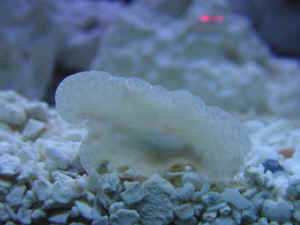 |
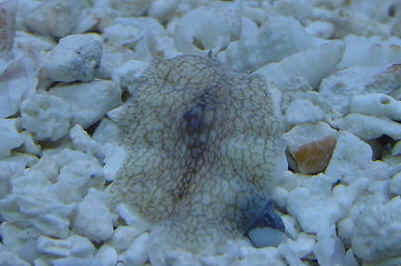 |
| Nuisance flatworms I don't really have
a question, but I did want to offer you the use of a photo I took
of my own flatworms. I haven't been able to find any
clear pics on the web of these little guys (eyespots and all) so I
thought it might be useful. <Thank you for sharing. Will post on
WWM for others edification> You have full permission to use it
or make whatever changes you want. It is located here:
<Again, thank you. Bob Fenner> |
|

|
| Critters...2/24/04 I was wondering if you
might be able to give me a bit of info on some critters in my tank.
After I sold my lunare wrasse I noticed some jelly like critters on
the side of the glass. They move kind of like a snail, but they
have no shell; The front part of them inflates and drags the rest
behind; They are a clearish white. I'm sending along a picture
I drew of what that look like, hope it helps. Any info will help,
thanks so much.... <The critters you described are a type of
flatworm. They are nothing to worry
about. Enjoy them while you have them as they tend to
rise and fall in population, often disappearing all
together. Best Regards. Adam> |
|
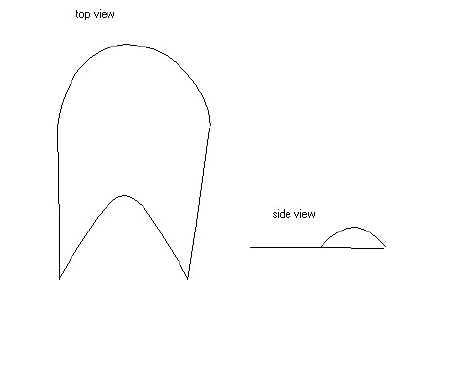
|
| Corallimorph Explosion? Bob Fenner and
crew, Thanks for all the help you offer to us hobbyists at no
charge. <What? Where's the free beer and dancing
girls?> You do a great job keeping things going for many of
us. A friend has posted a question on one of the reef forums
involving her mushroom corals. It appears to be in the process of
spitting out many baby Shrooms all at once. I've seen them
divide and split numerous times, but never anything like this. It
was suggested that it might be some kind of flatworm, but it
doesn't look like that to me. They LOOK like tiny Shrooms.
Whatcha think? <Is a flatworm infestation. A few things posted
re on WWM. Nice images. Bob Fenner> |
|
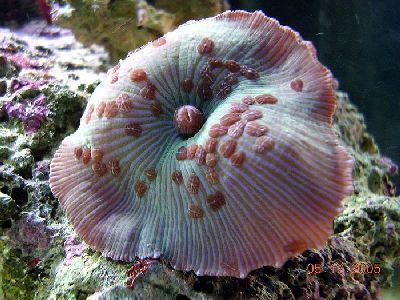 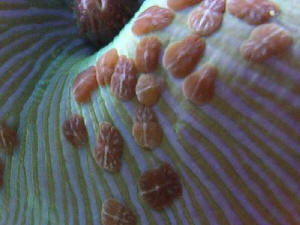
|
|
|

